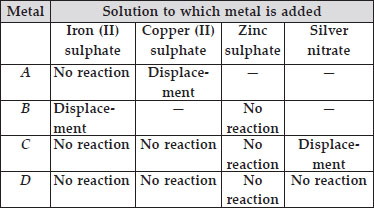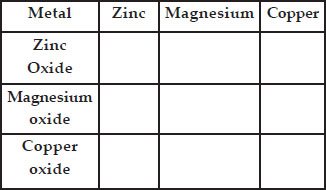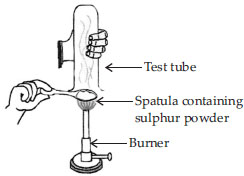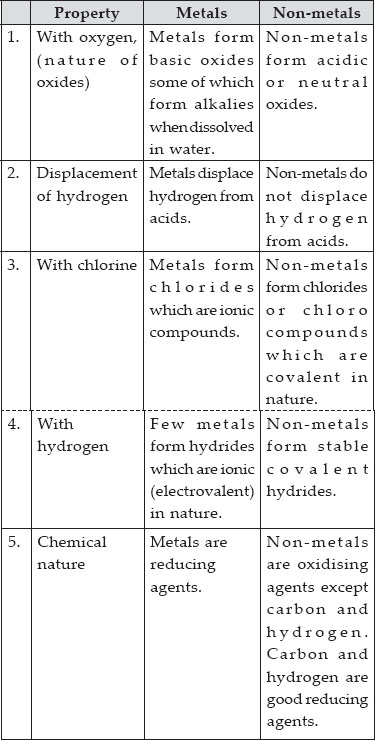Metals and Non-metals - NCERT Questions
Give an example of a metal which
A. is liquid at room temperature.
B. can be easily cut with a knife.
C. is the best conductor of heat.
D. is a poor conductor of heat.
Ans.: (a) Mercury
(b) Sodium
(c) Silver/copper
(d) Lead
Explain the meanings of malleable and ductile.
SOLUTION:Ans.: Malleable: The property due to which a substance can be beaten into sheets is known as malleability. Metals are malleable in nature.
Ductile: The property due to which a substance can be drawn into wires is known as ductility. Metals are ductile in nature.
Why is sodium kept immersed in kerosene oil?
SOLUTION:Ans.: Sodium reacts both with air and water. It is a highly reactive metal. When kept in open, it readily combines with oxygen present in air to form its oxide. Similarly, it reacts with water or moisture to form sodium hydroxide.

In order to preserve sodium metal, we generally keep it under kerosene so that neither air nor moisture may come in its contact.
Write the equations for the reactions of
A. iron with steam
B. calcium and potassium with water
Ans.: (a) 3Fe(s) + 4H2O (steam)  Fe3O4(s) + 4H2(g)
Fe3O4(s) + 4H2(g)
(b) Ca(s) + 2H2O(l)  Ca(OH)2(s) + H2(g)
Ca(OH)2(s) + H2(g)
2K(s) + 2H2O(l)  2KOH(aq) + H2(g)
2KOH(aq) + H2(g)
Samples of four metals A, B, C and D were taken and added to the following solutions one by one. The results obtained have been tabulated as follows :

Use the table given above to answer the following questions :
A. Which is the most reactive metal?
B. What would you observe when B is added to solution of copper (II) sulphate?
C. Arrange the metals A, B, C and D in order of increasing reactivity.
Ans.: Based on the activity series, the relative position of the metals involved in solutions is : Zn > Fe > Cu > Ag
Metal A is more reactive than copper and less reactive than iron.
Metal B is more reactive than iron and less reactive than zinc.
Metal C is more reactive than silver only and less reactive than other metals.
Metal D is the least reactive in nature.
In the light of above information, we can conclude that
(a) Metal B is the most reactive.
(b) Since B is more reactive than iron, it is also more reactive than copper. This means that it would displace copper from copper (II) sulphate solution. The blue colour of solution will slowly fade.
(c) The decreasing order of reactivity of metals is :
B > A > C > D.
Which gas is produced when a reactive metal reacts with dilute hydrochloric acid? Write the chemical reaction when iron reacts with dilute H2SO4.
SOLUTION:Ans.: Hydrogen gas (H2) is produced when a reactive metal reacts with dilute hydrochloric acid. Iron and dilute H2SO4 react as follows :
Fe(s) + H2SO4(dil.)  FeSO4(aq) + H2(g)
FeSO4(aq) + H2(g)
What would you observe when zinc is added to a solution of iron (II) sulphate? Write the chemical reaction that takes place.
SOLUTION:Ans.: The green colour of the solution would slowly disappear. Zinc would gradually dissolve and iron would get precipitated at the bottom of the beaker.
Zn(s) + FeSO4(aq) → ZnSO4(aq) + Fe(s)
(i) Write the electron-dot structures for sodium, oxygen and magnesium.
(ii) Show the formation of Na2O and MgO by the transfer of electrons.
(iii) What are the ions present in these compounds?
Ans.: (i) 
(ii) Formation of sodium oxide (Na2O)

Formation of magnesium oxide (MgO)

(iii) Na2O : Na+ and O2– ions
MgO : Mg2+ and O2– ions
Why do ionic compounds have high melting points?
SOLUTION:Ans.: In the formation of ionic compounds, positive ions (cations) and negative ions (anions) participate. These are closely packed and the ionic compounds exist as crystalline solids. They have strong interionic forces of attraction and have high melting and boiling points.
Q 10. Define the following terms :
(i) Minerals
(ii) Ores
(iii) Gangue.
Ans.: (i) Minerals : These are the combined states of metals generally with non-metals.
(ii) Ores : The minerals from which metals can be conveniently and profitably extracted are called ores.
(iii) Gangue : It represents the earthy impurities such as mud, sand and clay associated with the ore.
Name two metals which are found in nature in free state.
SOLUTION:Ans.: The metals are gold (Au) and platinum (Pt).
Q 12.Which chemical process is used for obtaining a metal from its oxide?
SOLUTION:Ans.: The chemical process is known as reduction. This reaction can be done either by heating with carbon or by using highly reactive metals such as Na, Ca, Al, etc. e.g.
ZnO(s) + C(s)  Zn(s) + CO(g)
Zn(s) + CO(g)
3MnO2(s) + 4Al(s)  3Mn(l) + 2Al2O3(s) + heat
3Mn(l) + 2Al2O3(s) + heat
This reaction is highly exothermic.
Metallic oxides of zinc, magnesium and copper were heated with the following metals.

In which cases, will you find displacement reactions taking place?
Ans.: Magnesium (Mg) will displace both zinc (Zn) and copper (Cu) from their oxides
Mg + ZnO  MgO + Zn
MgO + Zn
Mg + CuO  MgO + Cu
MgO + Cu
Zinc will displace copper from copper oxide.
Zn + CuO  ZnO + Cu
ZnO + Cu
Copper is least reactive and will not participate in displacement reaction.
Which metals do not corrode easily?
SOLUTION:Ans.: Metals such as gold (Au) and platinum (Pt) present at the bottom of the activity series do not corrode easily.
Q 15.What are alloys?
SOLUTION:Ans.: Alloys are the homogeneous mixture of two or more metals or even metals and non-metals.
Q 16. Which of the following pairs will give displacement reactions?
A. NaCl solution and copper metal
B. MgCl2 solution and aluminium metal
C. FeSO4 solution and silver metal
D. AgNO3 solution and copper metal
Ans.: (D) AgNO3 solution will give displacement reaction with copper (Cu) because copper is placed above silver in the activity series.
Q 17. Which of the following methods is suitable for preventing an iron frying pan from rusting?
A. Applying grease
B. Applying paint
C. Applying a coating of zinc
D. All of the above
An element reacts with oxygen to give a compound with high melting point. This compound is also water soluble. The element is likely to be :
A. calcium
B carbon
C. silicon
D. iron
Ans.: (A) Calcium (Ca) combines with oxygen to form calcium oxide (CaO) with very high melting point. It dissolves in water to form calcium hydroxide.
2Ca + O2  2CaO
2CaO

Food cans are coated with tin and not with zinc because
A. zinc is costlier than tin
B. zinc has higher melting point than tin
C. zinc is more reactive than tin
D. zinc is less reactive than tin
Ans.: (C) zinc is more reactive than tin and reacts with organic acids present in food to form poisonous compounds.
Q 20. You are given a hammer, a battery, a bulb, wires and a switch :
A. How could you use them to distinguish between samples of metals and non-metals?
B. Assess the usefulness of these tests in distinguishing between metals and non-metals.
Ans.: (A) Metals can be hammered to form sheets. Non-metals cannot be broken down into sheets.
(B) By making an electrical circuit, it can be tested for the electrical conductance of metals and non-metals.
What are amphoteric oxides? Give two examples of amphoteric oxides.
SOLUTION:Ans.: These are the oxides which can act both as acids and bases. For example, aluminium oxide (Al2O3) and zinc oxide (ZnO). The amphoteric character of zinc oxide is shown by the following reactions.

Name the two metals which will displace hydrogen from dilute acids and two metals which will not.
SOLUTION:Ans.: Metals such as Mg, Al, Zn, Fe, etc. which lie above hydrogen in the activity series are more reactive than hydrogen and hence can displace hydrogen from dilute acids. For example,

Metals such as Cu, Hg, Ag, Au, etc. which lie below hydrogen in the activity series are less reactive than hydrogen and hence cannot displace hydrogen from dilute acids.

In the electrolytic refining of a metal M, what would you take as the anode, the cathode and the electrolyte?
SOLUTION:Ans.: Anode : A thick slab of crude metal M.
Cathode : A thin sheet of pure metal M.
Electrolyte : A solution of a stable salt of metal M.
Pratyush took sulphur powder on a spatula and heated it. He collected the gas evolved by inverting a test tube over it, as shown in figure below.

A. What will be the action of gas on
(i) dry litmus paper?
(ii) moist litmus paper?
B. Write a balanced chemical equation for the reaction taking place.
Ans.: (A) When sulphur is heated in air, sulphur dioxide gas is formed.
(i) The gas has no effect on dry litmus paper.
(ii) The gas turns the moist blue litmus to red. On prolonged contact with the gas, the litmus paper gets decolourised.
(B) 
State two ways to prevent the rusting of iron.
SOLUTION:Ans.: (i) By applying a coating of grease or paint on the surface of iron.
(ii) By depositing a layer of zinc on the surface of iron. The process is called galvanisation.
What type of oxides are formed when non- metals combine with oxygen?
SOLUTION:Ans.: The oxides are generally acidic in nature which means that when dissolved in water, their solutions change blue litmus red. For example,

Give reasons for the following :
A. Platinum, gold and silver are used to make jewellery.
B. Sodium, potassium and lithium are stored under oil.
C. Aluminium is a highly reactive metal but still used for making cooking utensils.
D. Carbonate and sulphide ores are usually converted into oxides during the process of extraction.
Ans.: (A) These metals are placed at the bottom of the activity series and are very less reactive in nature. Gold and platinum are even known as noble metals. They are not affected by air, water and even by chemicals. Since they have bright lustre, jewellery can be made from them.
(B) All the three metals react with water producing lot of heat. As a result, hydrogen evolved catches fire. They cannot be kept in air also because air contains moisture or water vapours. These are kept under kerosene to avoid contact with both air and water.
(C) When exposed to air, the metal changes into its oxide called aluminium oxide (Al2O3). It gets deposited over the surface of the metal and forms a protective coating on the surface. Due to the presence of this layer, the metal becomes unreactive and can be used in making cooking utensils.
(D) Metal oxides can be easily reduced to metallic form with coke (C) or any other suitable reducing agent. Therefore, carbonates and sulphides are converted to the oxide form by processes of calcination and roasting.
You must have seen tarnished copper vessels being cleaned with lemon or tamarind juice. Explain why these sour substances are effective in cleaning the vessels.
SOLUTION:Ans.: Copper metal slowly reacts with water, carbon dioxide and oxygen present in air to form basic copper carbonate which is green in colour. Its layer slowly gets deposited on the surface of the metal.

Now as lemon is acidic, hence when we rub the tarnished copper vessel with lemon, the basic copper oxide or copper carbonate reacts with the acid present in lemon to form a salt which is washed away with water.
Differentiate between metals and non-metals on the basis of chemical properties?
SOLUTION:Ans.:

A man went door to door posing as a goldsmith. He promised to bring back the glitter of old and dull gold ornaments. An unsuspecting lady gave a set of gold bangles to him which he dipped in a particular solution. The bangles sparkled like new but their weight was reduced drastically. The lady got upset and after a futile argument, the man beat a hasty retreat. Can you predict the nature of the solution used by the imposter?
SOLUTION:Ans.: The man had actually used the solution of aqua regia (mixture of conc.HCl and conc.HNO3 in the ratio of 3 : 1 by volume) which dissolved gold forming soluble auric chloride (AuCl3). Since gold actually reacted, there was a loss in weight of the gold bangles. With the removal of the dull layer of gold from the surface, there was original shine on the bangles.
Q 31.Give reasons why copper is used to make hot water tanks and not steel (an alloy of iron).
SOLUTION:Ans.: Copper is a better conductor of heat than steel which is an alloy of iron. Though copper is costlier than steel, it is used to make hot water tanks for storing hot water in preference to steel.